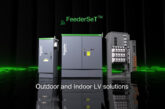
Recent regulation updates have increased awareness of surge protection devices. Here, Adrian Horsley, Technical Manager at DEHN, provides some advice on selecting the correct SPD for the job.
Surge Protection has always been covered in depth within BSEN62305-4, the current UK lightning protection standard. However, the recent amendments of the BS7671 17thEdition Wiring Regulations have increased awareness of Surge protection devices or SPDs.
Here we take a look at some of the important criteria when selecting SPDs such as ensuring the correct Type of SPD and its kA rating are selected in accordance with the standards.
SPD Type selection
There are three types of SPDs defined in BSEN62305 and EN61643-11. Additionally, combined SPDs have the distinct advantage of offering both Lightning protection and surge protection in one SPD.
Type 1 SPDs are designed to carry partial lightning  currents and are defined as being tested with a high energy 10/350µs (Iimp) wave shape. These Type 1 SPDs must be installed on incoming services (e.g. mains power and data ) when an external Lightning Protection System (LPS) is installed on a building. Where partial lightning currents can also flow due to a direct lightning strike on overhead supplies or externally mounted equipment, Type 1 SPDs should also be used.
currents and are defined as being tested with a high energy 10/350µs (Iimp) wave shape. These Type 1 SPDs must be installed on incoming services (e.g. mains power and data ) when an external Lightning Protection System (LPS) is installed on a building. Where partial lightning currents can also flow due to a direct lightning strike on overhead supplies or externally mounted equipment, Type 1 SPDs should also be used.
Type 2 and Type 3 SPDs are designed to discharge the induced surges created by lightning electromagnetic fields and also other transient surge events such as switching surges, supply faults etc.
These devices are defined as being tested with a specific energy wave shape of 8/20µs (In) for Type 2 SPDs or a combination wave shape for Type 3. For many applications where the requirement is to provide surge protection only, Type 2 and Type 3 SPDs play a critical role in protecting sensitive electronic equipment.
DEHN SPDs
Choosing the correct SPDs from DEHN will ensure compatibility with the requirements of BSEN62305 and also the 17th Edition.
kA Rating
Once the correct Type of SPD has been established, the next critical consideration in the SPD selection is its kA rating. The kA rating being the maximum amount of lightning current the SPD is designed to discharge and is extremely important when dealing with Type 1 SPDs that have to handle lightning currents.
When an external lightning protection system is installed on a structure it must as a minimum, also have Type 1 Lightning Current Arrestors installed on the incoming services for Lightning equipotential bonding purposes.
If a Risk assessment has been carried out to BSEN62305 the corresponding Lightning Protection Level (LPL) of the structure will be known and from this the required kA rating and limp values can be found.
However, in many cases a risk assessment may not have been carried out on the structure and these values will not be known. According to BS7671, “Where Type 1 SPDs are required, the value of Iimp shall not be less than 12.5kA for each mode of protection, if Imp cannot be calculated.”
Selecting a Type 1 SPD with a total kA rating (Itotal) of 100kA such as the DEHNventil will ensure protection to all Lightning Protection Levels even without having to carry out a risk assessment or Iimp calculation. For Lightning protection levels III and IV the DEHNshield is ideally suited with a total kA rating of 50kA.
Wave Breaker Function
Experience and testing has shown that even small amplitudes of 10/350 µs lightning impulse currents can overload or even destroy downstream SPDs and equipment if varistor based Type 1 lightning current arresters are used. Varistor based Type 1 SPDs limit the energy rather than switching the energy to ground.
As a result of this, a larger amount of the initial energy flows to downstream SPDs and equipment.
In Spark Gap based arresters, the energy is switched to ground and virtually the whole current flows through the Type 1 arrester thus reducing the energy flowing to downstream SPDs and equipment to an
acceptable level.
All Type 1 arresters from the DEHN Red/Line family are energy co-ordinated and are based on spark gap technology featuring this Wave Breaker Function.








